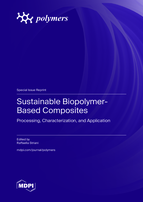Sustainable Biopolymer-Based Composites: Processing, Characterization, and Application
A special issue of Polymers (ISSN 2073-4360). This special issue belongs to the section "Polymer Applications".
Deadline for manuscript submissions: closed (30 July 2023) | Viewed by 97315
Special Issue Editor
Interests: photopolymerization; coatings; organic–inorganic hybrids; bio-based materials; waste valorization; biopolymers
Special Issues, Collections and Topics in MDPI journals
Special Issue Information
Dear Colleagues,
In the last several years, issues related to environmental pollution, health and safety have pushed the global research community to address new challenges in order to find valid solutions able to substitute petroleum-based materials, providing advantages for the environment and humans. In this scenario, bio-polymers have gradually caught on in several application fields in materials science, such as manufacturing, biomedical engineering, food industry, packaging, cosmetic and pharmaceutical industries, agriculture, energy sector, green nanotechnology, and recycling, by attracting the interest of the industrial world, which is increasingly forced to comply with restrictions for environmental and health protection. This Special Issue invites the research community to contribute with its own expertise, passion and science to expand the boundaries of knowledge by addressing new challenges. In particular, we welcome works proposing new biopolymer-based composites materials able to reach and overcome the properties and performances of traditional synthetic materials, with the great advantage of guaranteeing environmental sustainability. This Special Issue will publish innovative studies related to the development of bio-polymer-based composites by focusing the aim of the contributions (article, review, research report, etc.) on the processing, characterization and application fields to which the new material is intended.
Dr. Raffaella Striani
Guest Editor
Manuscript Submission Information
Manuscripts should be submitted online at www.mdpi.com by registering and logging in to this website. Once you are registered, click here to go to the submission form. Manuscripts can be submitted until the deadline. All submissions that pass pre-check are peer-reviewed. Accepted papers will be published continuously in the journal (as soon as accepted) and will be listed together on the special issue website. Research articles, review articles as well as short communications are invited. For planned papers, a title and short abstract (about 100 words) can be sent to the Editorial Office for announcement on this website.
Submitted manuscripts should not have been published previously, nor be under consideration for publication elsewhere (except conference proceedings papers). All manuscripts are thoroughly refereed through a single-blind peer-review process. A guide for authors and other relevant information for submission of manuscripts is available on the Instructions for Authors page. Polymers is an international peer-reviewed open access semimonthly journal published by MDPI.
Please visit the Instructions for Authors page before submitting a manuscript. The Article Processing Charge (APC) for publication in this open access journal is 2700 CHF (Swiss Francs). Submitted papers should be well formatted and use good English. Authors may use MDPI's English editing service prior to publication or during author revisions.
Keywords
- biopolymers
- sustainability
- bio-composites
- green engineering
- bio-based materials
- renewable resources
- biocompatibility
- biodegradability
- eco-friendly materials
- natural polymers







